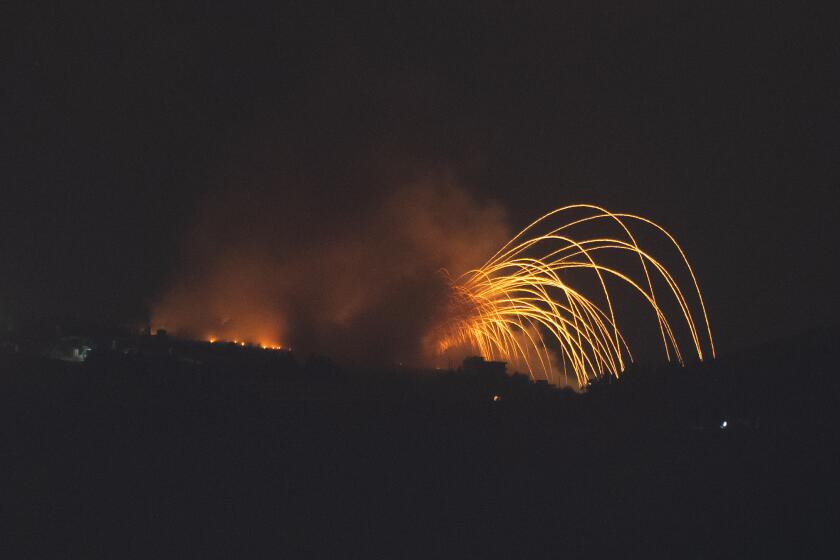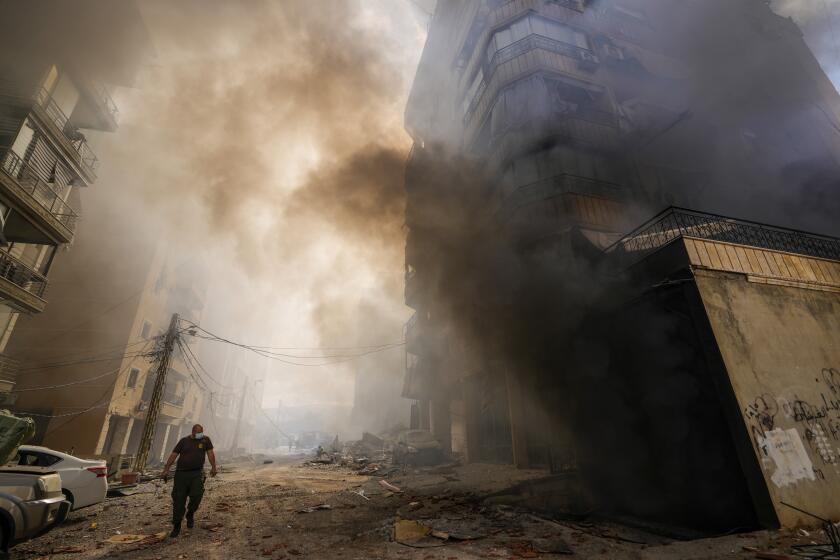
- Share via
MARJAYOUN, Lebanon — For much of the last year, as Hezbollah and Israel traded blows in an escalating tit-for-tat, the predominantly Christian village of Ain Ebel remained mostly out of the crossfire: Hezbollah cadres didn’t use the village as staging ground for attacks, and Israeli warplanes and artillery avoided striking it.
And while Hezbollah-aligned parts of southern Lebanon emptied of residents as the violence increased, many Christians in Ain Ebel and other mixed-religion towns and villages in the region stayed put.
That changed this week when Israel began its ground invasion. About 11 a.m. Tuesday, according to Ain Ebel Mayor Imad Lallous, calls started coming in to residents from the Israeli military, telling them they should evacuate immediately and not return until further notice.

“They told me, as the mayor, I should inform everyone to leave. But we have nothing to do with the fighting, we don’t have any political parties here, no Hezbollah, nothing,” Lallous said in a phone interview Wednesday.
Hours later, an evacuation order came on social media for more than 20 towns and villages, including Ain Ebel.
Much of Lebanon’s south falls under the de facto rule of Hezbollah, a Lebanese Shiite paramilitary faction and political party that the U.S. and Israel deem a terrorist organization. The Shiite majority in the area champion Hezbollah, crediting it for ending Israel’s 18-year occupation in 2000.
Israel began a ground invasion of southern Lebanon, vowing a limited operation targeting Hezbollah militants. Iran responded with a missile strike.
But scattered across this region’s tree-covered mountains, tobacco fields and orchards of apples and figs are predominantly Sunni, Christian and Druze towns and villages — most of which are at best ambivalent toward Hezbollah.
Many insisted on neutrality when the Iran-backed group began launching rockets across the border into Israel last year on Oct. 8, a day after allied, Gaza-based Hamas militants attacked southern Israel.
That neutrality has not spared those communities in recent weeks, as Israel has ramped up its assault on Hezbollah with thousands of airstrikes on wide swaths of the country and now a ground incursion.

Hezbollah appears outmaneuvered by a technologically superior foe that has assassinated much of its top leadership and destroyed a significant portion of its weapons.
Israel says it’s attacking Hezbollah positions, arms caches and infrastructure scattered all over Lebanon’s south. It also accuses Hezbollah of using civilians as human shields, an allegation the group denies.
On Monday, an Israeli strike hit Ibl al-Saqi, another Christian village on the border, wounding the priest there along with several others. The day before that, two missiles knocked down a pair of residential towers in the mixed Muslim-Christian village of Ein al Delb near Sidon, killing 45 people and wounding 58 others, authorities said.
A tally of casualties issued by the Lebanese Health Ministry since Israel began its escalated assault on Hezbollah in September puts the death toll at more than 1,300; it’s unclear how many of the dead are Hezbollah fighters, but the toll includes hundreds of women and children, the ministry said.

Iran and Israel trade threats of destruction, and Hezbollah and Israel report ‘close-quarter’ combat in Lebanon.
That’s why Lallous didn’t consider ignoring the Israeli order. “I couldn’t take the risk,” he said.
By nighttime Tuesday, the village of Ain Ebel was almost completely deserted, with only a handful of residents staying behind while the others fled to a monastery in the nearby Christian village of Rmeish.
“Why did they tell us to leave? I don’t know. I’m as confused as anyone about this,” Lallous said, a note of exasperation in his voice.
Hezbollah appears outmaneuvered by a technologically superior foe that has assassinated much of its top leadership and destroyed a significant portion of its weapons.
As it stands, it was just in time, said Father George Al-Amil, a Maronite priest in Ain Ebel. At 4 a.m. Wednesday, a missile hit a house in the village.
“It was empty and its residents are anyway not in the country,” he said, speaking from Rmeish.
“No one understands why this is happening. We’ve never seen any movement from Hezbollah in these areas.”

The Israeli military did not respond to questions about the evacuations of Ain Ebel and the targeting of other communities.
Confusion has been the dominant emotion among those who left Ain Ebel, joining what authorities say are an estimated 1.2 million Lebanese displaced in the last week. Many are angry, saying that Israel’s actions ensure their homes will become part of the battlefield.
A strike in Shebaa, Lebanon, kills a family of nine, including a woman eight months pregnant, reflecting the horror of the growing violence between Israel and Lebanon.
That’s what happened in 2006, when the village was the site of clashes between Hezbollah and Israel during a 34-day war, leaving homes destroyed, fields burned and residents besieged with no bread for 20 days. Others echo that point, and reject the Israeli military’s repeated assertion that Hezbollah is using villagers as human shields.
“No one is using us as human shields. If anything, people stay behind to shield the village,” said Jasmin Lilian Diab, who is from Ain Ebel and is director of the Institute of Migration Studies at the Lebanese American University.
She said trauma from earlier conflicts colors how villagers view this one. As a child during Israel’s occupation of south Lebanon, she remembered driving through an Israeli checkpoint to go home, and of hiding under her bed for days during the 2006 war.
“An important reason people don’t leave is also the fear of not being able to return,” she said.
“‘People ask, ‘What if I leave my home tonight, and then like in so many conflicts, we never get to come back? What if I leave my village tonight and it’s no longer accessible to me in the morning?’ ”
Diab acknowledged that she, like others from Ain Ebel and areas uninvolved with Hezbollah, had a “complicated relationship” with the group and its entry into a war without the Lebanese people’s consent. But, she said, the anger is “more towards Israel as an occupier.”
Similar fears of history repeating itself are growing in Marjayoun, a Christian town about five miles from the Israeli border and once the headquarters of the now defunct South Lebanon Army, a militia Israel funded to help its troops police occupied parts of southern Lebanon in the 1980s and 1990s.
The conflict between U.S.-backed Israel and Iran-backed Hezbollah could reach unprecedented levels of danger and destruction if it becomes all-out war.
The Lebanese group, working in concert with Israeli soldiers, was accused of torturing and killing compatriots, forcibly conscripting males over the age of 15 and uprooting families who refused.
On Thursday, after the Israeli military expanded its evacuation list to encompass 20 additional towns and villages, including those stretching north of a United Nations-mandated buffer zone, people in Marjayoun — which thus far has not been included in any evacuation order — girded themselves for a war coming ever closer.
“We’ve heard so many bombs here, even a child can distinguish the sounds now,” said Hassan Al-Abla, a 78-year-old retiree still in Marjayoun. As he was speaking, a bass-drum thump sounded in the air. He raised a finger. “Hear that? That’s the firing sound. Now you’ll hear the impact,” he said. A beat later came a louder bang and a column of smoke rose over a nearby mountain. Al-Abla gave a wan smile.
“See what I mean?” he asked. “This is how it is all the time now.”
In the morning hours before the evacuation order for towns and villages near Marjayoun, roads to the north were mostly deserted, except for a few cars barreling past at high speed. During a journey through towns and villages on the road back to the coast from Marjayoun, most places showed no signs of life: no vehicles, no people, only a single stray cat streaking across the road.
The sense of isolation is growing, said Archbishop Elias Kfoury, the Greek Orthodox archbishop for Sidon, Tyre, Marjayoun and other areas in the south. In a telephone interview Thursday, he excoriated the Israeli military for bombing roads linking Marjayoun to other areas in the south.
“People want to be able to go to hospitals or clinics, or their livelihoods,” he said. “No one is passing weapons on those roads.”
Asked about what it would mean if Marjayoun too was told to evacuate, Kfoury grew angrier.
“We aren’t in this war. Why are we being targeted? People are living in their homes, and have no link to Hezbollah or any group at all,” he said.
“The question should be directed to those who want us out.”
More to Read
Sign up for Essential California
The most important California stories and recommendations in your inbox every morning.
You may occasionally receive promotional content from the Los Angeles Times.















